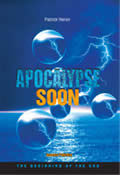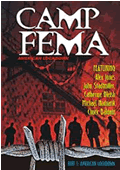PART 2
By Thomas R. Horn
March 31, 2015
NewsWithViews.com
On the third generation medicine man, giants, and the deceiving reptilian that came down from heaven
We had been told of the more than four thousand archaeological sites and six hundred cliff dwellings ascribed to the Anasazi—a mysterious people that had kept no written records yet who built mesa-top villages and absolutely astonishing cliff dwellings within caves and under outcroppings in the sides of these canyons, but nothing could have prepared us for how breathtaking what they had accomplished really was.
Our
Cherokee guide had obviously seen this before, as he waited for us
to take it all in. Just ahead of us stood an outstanding complex that
some archaeologists say was built long before the time of Christ and
that had been suddenly and mysteriously abandoned at least eight hundred
years ago (but keep in mind most everything about the Anasazi is anybody’s
best guess).  Clothing,
tools, and even food items were included in the materials they had
quickly left behind. This one location alone was a small city, three
stories high and built right inside a sheer mountain wall, yet more
than six hundred other such cliff dwellings lay ahead.
Clothing,
tools, and even food items were included in the materials they had
quickly left behind. This one location alone was a small city, three
stories high and built right inside a sheer mountain wall, yet more
than six hundred other such cliff dwellings lay ahead.
Among the many Anasazi settlements we would visit during this expedition (and equally as grandiose as the best we had seen) is a place called the Spruce Tree House. It is the third-largest cliff dwelling in the area, and I mentioned this one in particular because it is a site that YOU can visit at the Mesa Verde National Park! If you want to catch a glimpse of what we were investigating throughout this ancient and mysterious region, I recommend that you do go there (or perhaps we should all get together and take a SkyWatch TV tour?) The Spruce Tree House is an amazing, 216-foot-long, 89-foot-deep,120-room structure, with ten gathering rooms, eight ceremonial kivas, and two towers, all built into the side of a cliff from stones cut and hauled from a river several miles away.
These compounds built into the high rock ledges along the Mesa Verde valley are constructed from very accurately cut stones that were set in mortar. Even after eight hundred-plus years of abandonment, the walls remain remarkably strong. You can also see the hand and footholds cut into the cliff faces that served as the frightening climbing apparatus, which the inhabitants would scale along these sheer mountain walls in order to tend their gardens on the top of the mesa, where they grew beans, squash, and corn.
Day after day, hour after hour, as we advanced to study these structures, we couldn’t help but wonder why the Anasazi would have ascended such terribly dangerous circumstances to carve out such amazing fortresses. What they did was far beyond the need to provide for shelter and protection from cougars and bears. It would have been a thousand times easier to construct and defend their lodgings near the river from which the stones had been harvested—unless, of course, they were trying to defend themselves from something more dangerous than rival tribes, bears, and large cats. All we could imagine was that this tremendous amount of additional effort had something to do with the need for a literal citadel of fantastic defensible proportions.
But from what?
We
believe we found the incredible…and scary…answer to that
question later when viewing and deciphering the ancient petroglyphs
the Anasazi left behind. They tell an amazing story, and it is one
that corresponds quite well with biblical history. Even the medicine
man we would visit the following day  admitted
this fact.
admitted
this fact.
Anasazi ruins the public can visit at Mesa Verde National Park
As we went along, our guide also had theories about the Anasazi people, offering his assumptions about how they lived, how they constructed these cities, and why they departed in what seemed like overnight. He told us these thoughts as he led us farther into the hidden settlements where the public is not allowed to stand and showed us one of the kivas that did not have a roof on it (kivas were built both ways, some with roofs and some without). One kiva he brought us to was a round room, approximately eighteen feet across and built ten feet down into the floor of the ruins. Other kivas in this valley have roofs where a single ladder would have descended into the center of the space through a three-foot hole. He explained how the kivas were (and are) used for rituals, including how ceremonial tools that archaeologists found hidden in the niches of these ancient kivas had been used by medicine men to open the portals the upcoming book On The Path Of The Immortals unearths (available in May), in order to contact parallel realities. Then he led us a short distance away to a hole in the ground where a ladder made of tree limbs tied together with leather straps was barely jutting up from out of the earth. This was another underground kiva, and he asked if we would like to enter it. Keep in mind that while we had spent days in prayer and preparation for this investigation, we paused at this point to think about this and to pray over ourselves. Kivas are thought in many indigenous belief systems to be a portal to another world, a place where the kachina spirit-beings can manifest and interact with medicine men (what some call a shaman). But the Cherokee assured us that inside this kiva, the hole in the floor that served as the symbolic place of origin of the tribe—what the Hopi call sípapu from which the peoples emerged from the underworld and where the dead still can be summoned according to their religion—had been plugged and buried. This was done when the kiva was abandoned and the tribe wanted the sípapu-doorway closed to protect entry into the lower world. Some medicine men—like the one we would encounter the following day—even say a “gatekeeper” exists just beyond the sípapu, and when the ceremony is performed, this gatekeeper might not let a person who is improperly prepared pass into the beyond, lest he or she should suddenly be afflicted by hungry ghosts that inhabit the domains of their ancestors.
Moments
later, as we descended into this part of the ancient world, I found
the wooden ladder to be completely smooth, hand polished as if from
some long-forgotten, frequent use. The only light coming in was from
the small hole we had just climbed through. Carl turned on a flashlight,
and I noted the temperature was just a bit cooler than the outside
air above. The roof was made from what appeared to be cedar logs;
the walls were of stone and mortar. There was a ledge all the way
around the perimeter to sit on, and we saw evidence of where a fire
pit with a ventilation hole on one side had once  existed.
It was opposite a small niche on another wall that also had been filled
in. Near the very center, we could see where the sípapu had
once been, and we were glad that it was no longer there.
existed.
It was opposite a small niche on another wall that also had been filled
in. Near the very center, we could see where the sípapu had
once been, and we were glad that it was no longer there.
Tom Horn descending into underground kiva
As the rest of the crew made it down into the kiva, it was hard to grasp the fact that we were in a ceremonial room that may have existed many hundreds—perhaps even thousands—of years before Christ had walked the earth in the flesh. It was also a place that may have been abandoned due to some of the same enemies Jesus and even the ancient Hebrews faced. I'll talk more about that later, but you should be aware that our guide pointed out an area we were not allowed to enter and said that the kiva for the advent of the Fifth World (the end times according to Hopi and other indigenous faiths) was already built there and it is where the tribes will come during the coming time of great tribulation. Suffice at this juncture to say I was literally astonished that the "safe place" where all the nations will go is supposedly already built in anticipation of apocalyptica? Even now I am left with dozens of unanswered questions if that is true. How big is this underground structure? When was it built? How much money did it cost? How could it have been carried out without people's knowledge? Was this Cherokee pulling my leg? He didn't act like it.
After filming the interior of the primeval kiva and pointing out certain aspects for the upcoming television special, we returned to the surface, and our guide asked what else we were hoping to see that might need special permission. Carl told him of specific ruins that he had heard about, as well as (and in particular) petroglyphs of giants and other Old Testament-themed images that I myself wanted to see. The Cherokee nodded and smiled, and said, “I know the places you speak of. One of them is called the Sun Temple on the other side of the mesa. We don’t know what it was built for but they left it unfinished. And I can tell you where to see the petroglyphs you seek on the reservation, but I cannot go there with you.”
The Sun Temple was indeed ruins that I wanted to see, because it is a large and significant site that holds much mystery in that nobody, including archaeologists and cultural historians, know what it was for. An eroded stone basin with three indentations at the southwest corner of the structure suggests that it may have been purposed as a sundial to mark the changes in the seasons. Two kivas on top of the structure, together with the lack of windows or doors elsewhere, intimates that it was not meant for housing, which has led modern Pueblo Indians to propose that it was some type of ceremonial structure probably planned for ritual purposes dedicated to the Sun God. The amount of fallen stone that was removed during its excavation is said to indicate that the original walls were between eleven and fourteen feet tall. These walls were thick, double-coursed construction, with a rubble core placed between the panels for strength and insulation. After studying the Sun Temple and comparing it to ancient Mesoamerican culture and edifices, it is this author’s opinion (which is as good as anybody else’s, since we don’t really know) that this site may have been intended as a place for human sacrifice similar to those of the Aztec and Maya. I say this for a couple reasons. First, Dr. Don Mose Jr., a third-generation medicine man we met with for a large part of a day during this investigation (more about him below and in the upcoming book), told us that the oldest legends of the Anasazi, which he had been told by his great-grandfather (who likewise had been told by his ancestors) included stories of the Anasazi turning to sorcery, sacrifice, and cannibalism after they “lost their way” and were driven insane by a reptilian creature, which they depict with a halo above his head. (Images of this being are included in the petroglyphs we filmed inside the canyons, and I believe they likely attest to the fallen reptile [or reptiles] of biblical fame, which also misled humanity.) Second, blood sacrifice was a religious activity in most premodern cultures during some stage of their development, especially as it involved invoking the gods, and the “Sun God” was typically chief among them. This included animals and humans or the bloodletting of community members during rituals overseen by their priests. In fact, the Mayans—who may have influenced the Anasazi or vice versa—believed “that the only way for the sun to rise was for them to sacrifice someone or something every day to the gods.”[i]
 Tom
Horn stands at the wall of the Anasazi Sun Temple, where he believes
human sacrifices may have been intended
Tom
Horn stands at the wall of the Anasazi Sun Temple, where he believes
human sacrifices may have been intended
We will probably never know for sure what the purpose behind the Anasazi’s Sun Temple was going to be or why it, like everything else these people built, was suddenly abandoned. Some evidence exists of a twenty-year drought from AD 1276 to about 1299, which can be seen in ancient tree rings, and some believe this may have contributed to the Anasazi having simply migrated away from the area. The big problem with this theory is that it does not explain why all the important foods, salts, clothing, and everything else that would have been so exceptionally important to the Anasazi were left behind. Another theory is that as the population grew, social divisions or war developed among some of the communities. But again, no evidence supports this conclusion, and the National Parks Department’s research, archaeologists, and even the native peoples themselves admit it is impossible to know for sure why these mysterious cliff dwellers were there one day and gone the next. Even the assumption by historians that the modern Pueblo peoples of the Hopi, Zuni, Acoma, and Laguna are the descendants of the Anasazi is a theory that contradicts some of their own histories. A Native American cultural historian we interviewed told us that by the time his people first arrived in the Four Corners area, they found the Anasazi long gone and went looking for them everywhere. They did not know who or where they were, and when finally his people reached Chaco Canyon in New Mexico (which they assumed had been the Anasazi capital) in search of them, and found it also in ruins and abandoned, they sat down and wept over what possibly could have happened to such a great culture.
Thankfully, it was while contemplating these questions (and more) that lead investigator Carl Olafsen’s cell phone rang and on the other end of the line was a man who would definitely provide some of the answers. We had been hoping to get an audience with him—and had nearly given up when Don Mose Jr., the third-generation medicine man I mentioned earlier, called. Known to be sensitive to Christianity, this retired Navajo academic authored many of the Nation’s schoolbooks as well as cultural programs throughout the Four Corners area and, as we would discover, is a proficient Native American storyteller (oral-traditions historian).
NAVAJO NATION MEDICINE MAN
It was a crisp, February morning the following day as we departed the Navajo Nation’s headquarters to meet with Dr. Mose. The views on our drive were amazing, with spires that arose hundreds of feet from out of the earth, with enormous rocks often balanced precariously on their tops and accessorized by tremendous sandstone mounds and colored plateaus for as far as our eyes could see. With vast blue mountain skies hovering lightly above us, this backdrop of mesas and spires painted in yellows, oranges, and different shades of reds were richly inspiring as a few hours later we neared the traditional hogan (a nine-pillared round room made from cedar logs and mud) in the Monument Valley, where Dr. Mose had said he would meet us.
Like something straight out of an Old West movie, he was standing there in front of the Navajo structure as we drove up, hands on his hips, adorned in cowboy boots and a well-worn straw cowboy hat (ironic, right?), along with a turquoise watch, rings, and belt buckle. Black, slightly curly hair dangled along his shoulders and down his back as he regarded us with a welcoming smile. As Carl and Allie got out of the SUV and went up to greet him, I estimated that he stood about five feet, four inches, and no more. He seemed pleased to meet them and more than eager to get started telling the tales that we had asked him to clarify for us—stories that his father and grandfather had passed down from generations before, stories of giants, stories of “alien slaying” heroes of lore, and more.
Following him, Allie and Carl entered the hogan with me and the cameraman bringing up the rear. I took note that this was a customary large mud hut with an opening on one side and a chimney pipe extending up through the center of the roof. It was surprisingly warm. Dr. Mose had obviously lit a fire in anticipation of our arrival. The smell of cedar permeated the room, and I could not distinguish if this was from the fire or from the cedar log beams, walls, and ceilings. The only light that shone in was from a hole in the center of the ceiling that let the smoke from the fire exit out. Places to sit were all around the perimeter wall against the reddish-brown clay and sand-mixed floor. Dr. Mose invited us to sit down, and he motioned for Carl, who had made the initial contact, to sit down next to him. He formally introduced himself to Carl by putting his thumb to his chest, then saying his name. Using his opposite hand to indicate his index finger, he named his mother’s clan. Moving to his middle finger, he regarded his father’s clan. Ring finger, grandmother’s clan. Pinky, grandfather’s clan. Then he smiled and offered Carl his hand, explaining that by greeting him in this way, not only was he shaking his hand, but he was extending the greetings of his entire family. Carl looked honored, and happily shook not only Don’s hand, but vicariously, the hands of his entire family.
With that, Dr. Mose immediately began talking as if on autopilot while our technician raced to set up the recording equipment. The cameraman said, “Hang on a second. Can we move to where there is more light and start over?” The aged medicine man hardly looked up as he replied, “No, no, I like to tell it here. This is where I tell it. Catch up,” and with that, he continued on where he had just left off, drawing in the sand on the floor and reciting the first part of the story of the ancient Anasazi as it had been repeated to him by his father and grandfather, who had been told by their ancestors, and so on—a legend that Dr. Mose alone had undoubtedly repeated hundreds of times before.
Since
it was obvious that this Navajo historian was indifferent to our camera
and recording plans (and, in fact, I could tell he was uncomfortable
with us putting him on film, but thankfully he proceeded nevertheless),
I stepped over to Joe Ardis (yes, the “Wild Man of the Ozarks”
was our cameraman once again) and whispered, “Forget the lights
and your usual setup checks and get the camera on him now; he’s
not going to stop!” With that, Joe quickly unhooked the camera
from the tripod, sat down next to Carl and Dr. Mose, and proceeded
for nearly two hours to record what has only ever been allowed a few
times in history before: the white man putting on film the official
and legendary stories of creation, giants, a great flood, the reptilian
deceiver, and more, all from the voice of the nation’s medicine
man. Dr. Mose even sang to us in the antiquated tongue and recited
parts of what I would call “Old  Testament
history” paralleled in their earliest antiquity using the Navajo
language.
Testament
history” paralleled in their earliest antiquity using the Navajo
language.
Dr. Don Mose, third-generation medicine man and Navajo oral historian gives rare interview to SkyWatch TV non-tribal members
Not only did Dr. Mose substantiate the age-old and globally recorded story of “those who come through portals” and the impact they have had on biblical and global history past and present, and not only did he weave Navajo Indian myths and legends seamlessly with our understanding of the six days of creation, the arrival of Nephilim, and their connection to judgment by a global flood followed by the repopulating of peoples around the world and a second incursion of giants, but there were several instances in which, when I pushed him for greater detail, Dr. Mose went off script (he actually delineated from the official Navajo storyline) to provide greater consistency between history and the way the Bible itself recorded certain events.
For example, as the medicine man was following the “official storyline” about the Anasazi and how they didn’t disappear but rather migrated and became the modern Pueblo Indians, I expressed doubts about that theory, and he responded by grinning just a bit and saying, “Well, I probably shouldn’t tell you this, but—”. He then proceeded to tell us the older stories that his grandfather had repeated about these mysterious peoples actually disappearing after they came under mind control from a reptile with a halo, a carnivorous creature suspiciously similar to what Cris Putnam thoroughly examines in the upcoming book On The Path Of The Immortals as “fiery seraphim” (Hebrew: saraph, “fiery serpent,” also corresponding with many other testaments around the ancient world, including Sanskrit sarpa, sarpin—“reptile”—whether with legs like the lizard or legless like the snake).
Another
case in point is when I told him what we had learned from the Apache
about cannibalistic giants and God destroying them in the Flood. “Oh,
yes,” he said, reaching for an illustrated book he authored
that is used in the Nation’s schools and libraries. He opened
it to show us an artist’s depiction of a giant that had stood
between thirty and forty feet tall: “There was a time when the
earth was infested with such great giants and alien gods that destroyed
and ate the people,” he said. “Some of them were in human
form; others were monsters and [human-animal hybrids].” He followed
this with the story of the White Shell Woman, who gave birth to two
of the most important characters in Navajo mythology—the twin,
miracle-performing sons named Naayéé’ Neizghání
(whose name means “Slayer of Alien Gods”) and his twin
brother, Tobadzischini. Together, these two great warriors killed
many of the giants,  hybrids,
and monsters that were wantonly destroying human life. As Dr. Mose
described these ancient tales, I could not help but think of David
killing Goliath and then later other giants with his mighty men.
hybrids,
and monsters that were wantonly destroying human life. As Dr. Mose
described these ancient tales, I could not help but think of David
killing Goliath and then later other giants with his mighty men.
Image showing Dr. Mose drawing out shapes and symbols on the floor as he tells the ancient stories of creation, vortices, heroes, reptilian deceivers, giants, and the Flood.
The storyteller then paused and said, “You know, when the Christian missionaries first came to America and told our people their stories of the giants and the Great Flood, we smiled and let them know we had already heard these tales long ago from our ancestors.” Perhaps this fact is why so many American Indians find it natural to convert to Christianity or why the Nations seem to have no issues with many of their tribal elders and educators being converts to Christianity.
|
|
Another hour passed by as we gathered these stories and songs on film, and finally Dr. Mose finished his anecdotes. As we rose to thank him and to pack up our gear to leave, Carl noticed that the old man was very carefully using his foot to wipe clean the earthen canvas he had created with his finger that afternoon. Every brushstroke was erased. None of the art would ever leave the hogan. The story was to be memorized so that it could be passed on in words and songs for generations to come. This is the storyteller’s way. This is the science of oral history. And with that, the medicine man shook Carl’s hand, then ours, and we watched as he shuffled outside and down the trail. A slight wind kicked up dust around his feet as he went, and I could almost hear the ancient “Diné Bahane” (Navajo story of creation) whispering in the air through this purple mountain range, the ancient tribal language and traditional Navajo rattles and flutes somehow still resonating their imprint over the hills from a time long ago.
TO BE CONTINUED...
NOW, FOR THE FIRST TIME, ON THE PATH OF THE IMMORTALS REVEALS…
•
Caught on film! Hyperdimensional denizens and their craft on exclusive
footage!
• Unveiled! What Mt. Graham really is, and
why NASA is seeking “Dark Matter” there
• Confirmed by Scientists! The Milky Way’s
galactic transport system
• The role of CERN’s Large Hadron Collider
and its search for portals
• New secrets from Gobekli tepe, Baalbek, and
of the coming immortals
• The worldwide grid that ties “them”
all together
• Unearthed! Giants, cryptids, and their mysterious
“gates”
• The Ancient Native American prophecy that
predicts destruction of the USA
• The Vatican’s “vortex”
and the power it is generating
• Filmed! A dimensional portal on famous “Bradshaw
Ranch” and the light-being that came out of it just as a gigantic
v-shaped craft buzzed our team (also filmed).
• Discovered! The 6-toed giants and fallen
reptilian “savior” that wiped out the Anasazi!
• What the Bible pre-told about the gateways
and the beings that wait behind them.
In On the Path of the Immortals, internationally acclaimed, investigative authors Thomas Horn and Cris Putnam continue the greatest investigation of our time by exposing the facts kept hidden from the public by elitists and intellectuals who are planning mankind’s assimilation under a coming “savior,” one whom the prophet Daniel foresaw as “an alien god.”
Click here for part -----> 1, 2, 3,
© 2015 Thomas Horn - All Rights Reserve
Thomas Horn is the CEO of RaidersNewsUpdate.com and SurvivorMall.com.
Over the last decade, he has authored three books, wrote dozens of published editorials, and had several feature magazine articles. In addition to past articles at NewsWithViews.com , his works have been referred to by writers of the LA Times Syndicate, MSNBC, Christianity Today, Coast to Coast, World Net Daily, White House Correspondents and dozens of newsmagazines and press agencies around the globe. Tom's latest book is "The Ahriman Gate," which fictionalizes the use of biotechnology to resurrect Biblical Nephilim.
Thomas is also a well known radio personality who has guest-hosted and appeared on dozens of radio and television shows over the last 30 years, including "The 700 Club" and "Coast to Coast AM." When looking for a spokesperson to promote their film "Deceived" staring Louis Gossett Jr. and Judd Nelson, "Cloud 10 Pictures" selected Thomas as their spokesperson to explain the Christian viewpoint on UFO-related demonology.
Web Site: RaidersNewsUpdate.com
E-Mail: RaidersNewsUpdate@gmail.com















 Share This Article
Share This Article






